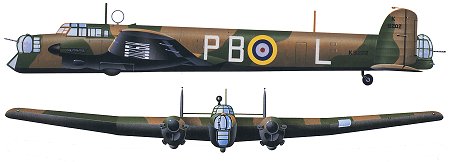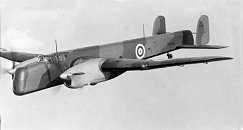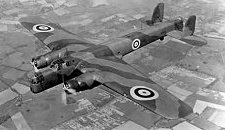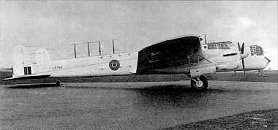
Armstrong Whitworth Whitley
The Armstrong Whitworth Whitley was designed in 1934 and first flown in 1936 with its original powerplant of twin Armstrong Siddeley Tiger radial engines. These were used on the earlier variants of Mk I, II and III, but later models were powered by Merlin inline engines, which boosted maximum speed by 84 km/h (52 mph).
There were only 40 Mk IVs, but nearly 1500 of the Mk V, which remained in production from 1939 until 1943. The Mk IV had introduced a powerful tail turret with four machine guns, and the Mk V had a slightly longer fuselage to extend the tail gunner's field of fire.
Whitleys carried out the majority of the controversial leaflet raids during the first year of the war and joined the night bombing offensive in 1940, taking part in the first raid on Berlin in August. The Whitley remained in front line service with Bomber Command until the spring of 1942.
Some Mk Vs had been transferred to Coastal Command early in the war for use in maritime patrol and another 146 were built as Mk VIIs with long range search radars capable of detecting submarines. These were active from March 1941 over the Atlantic with the first U-boat kill from an aircraft equipped ASV radar in November 1941. They remained in service until early 1943.
Whitleys were used as paratroop trainers and glider tugs from 1940, while 12 Mk Vs were converted to freighters in 1942 and used by British Airways.
Along with the Vickers Wellington and Handley Page Hampden, the Whitley was one of the Royal Air Force's three principal bomber types at the start of World War Two. Though the oldest of the three, it was to become the first British aircraft to drop bombs over both Germany and Italy. It was also the first to be equipped with radar for anti-submarine warfare. It also went on to fill several other roles, including paratrooping aircraft on special operations. Whitleys were often used for paradropping agents behind enemy lines.
|

|
 |
 |
 |
| The Whitley Mk I, originally powered by two Armstrong Siddeley Tiger engines. Also note the dihedral (tilt) on the outer wings |
The first Whitley prototype had straight wings, but from the second prototype onwards, a small dihedral (tilt) was added to the outer wing panels. |
The Mk VII was slightly slower due to the drag from its ASV radar dipoles on the fuselage, under the wings and nose. Whitleys carried out many roles, including ASW, night bombing, leaflet dropping and agent insertions. |
|
Armstrong Whitworth Whitley (Technical Specification) |
| Role |
Bomber, reconnaissance, anti-submarine aircraft |
| Manufacturer |
Armstrong Whitworth |
| Maximum Speed |
367 kmh (228 mph) |
| Maximum Range |
2540 km (1500 miles) |
| Ceiling |
5,395 meters (17,700 feet) |
Weight
Empty
Maximum Takeoff |
8,759 kg (19,310 lbs)
15,164 kg (33,431 lbs) |
Dimensions
Wingspan
Length
Height
Wing Area |
25.60 meters (84 ft)
22.10 meters (72 ft, 6 in)
4.57 meters (15 ft)
105.63 square meters (1,137 sq ft) |
| Engines |
Two Rolls Royce Merlin X inline piston engines each providing 895-kW (1,200 hp) |
| Armament |
Five 7.7mm machine guns
Bomb capacity of 3,168 kg (6,698 lbs); usually fourteen 227 kg (500 lbs) bombs |
Photo Gallery
[an error occurred while processing this directive]
Click here to submit your photo
| Have A Passion For Aircraft? |
Subscribe to our 14 series FREE newsletter
delivered weekly on World War 2 Aircraft factfile... |
| NB:- We hate spam as much as you do, so your email address will NEVER be shared with or sold to anyone else. That's a Guarantee. |
|
|





